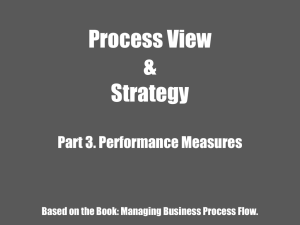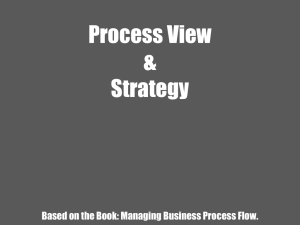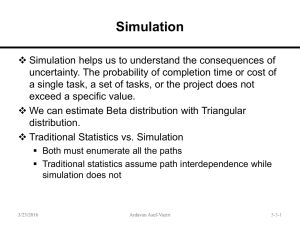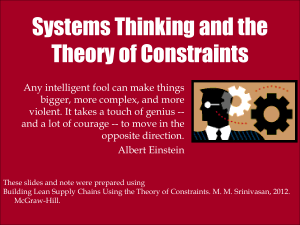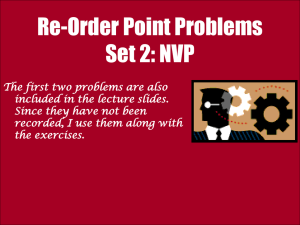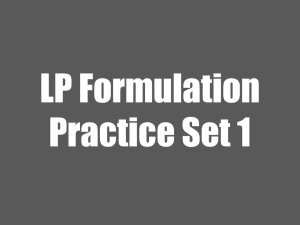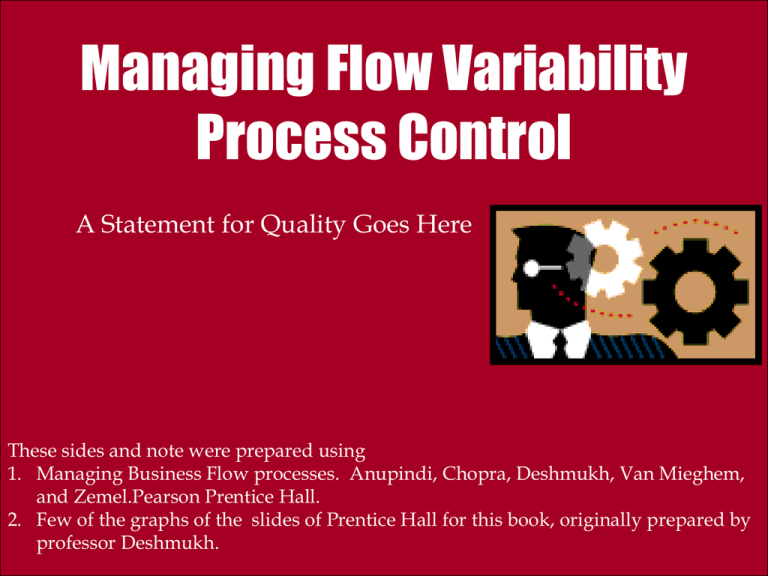
Managing Flow Variability
Process Control
A Statement for Quality Goes Here
These sides and note were prepared using
1. Managing Business Flow processes. Anupindi, Chopra, Deshmukh, Van Mieghem,
and Zemel.Pearson Prentice Hall.
2. Few of the graphs of the slides of Prentice Hall for this book, originally prepared by
professor Deshmukh.
Introduction ~ The Garage Door Manufacturer
According to the sales manager of a high-tech manufacturer of
garage doors, while the company has 15% of market share,
customers are not satisfied
Door Quality in terms of safety, durability, and ease of use
High Price compared competitors’ process
Not on-time orders
Poor After Sales Service
We can not rely of subjective statements and opinions
Collect and analyze concrete data –facts- on performance
measures that drive customer satisfaction
Identify, correct, and prevent sources of future problems
Quality – Process Control
Ardavan Asef-Vaziri
Jan-2012
2
9.1 Performance Variability
All internal and external performance measures display vary
from tome to time.
External Measurements - customer satisfaction, product
rankings, customer complaints.
Internal Measurements - flow units cost, quality, and time.
No two cars rolling off an assembly line have identical cost. No
two customers for identical transaction spend the same time in
a bank. The same meal you have had in two different
occasions in a restaurant do not taste exactly the same.
Sources of Variability
Internal: imprecise equipment, untrained workers, and lack of
standard operating procedures.
External: inconsistent raw materials, supplier delays, consumer
taste change, and changing economic conditions.
Quality – Process Control
Ardavan Asef-Vaziri
Jan-2012
3
9.1 Performance Variability
A discrepancy between the actual and the expected
performance often leads to cost↑, flow time↑, quality↓
dissatisfied customers.
Processes with greater variability are judged less satisfactory
than those with consistent, predictable performance.
What is the base of the customer judgment the exact unit of
product or service s/he gets, not how the average product
performs. Customers perceive any variation in their product or
service from what they expected as a loss in value.
In general, a product is classified as defective if its cost, quality,
availability or flow time differ significantly from their expected
values, leading to dissatisfied customers.
Quality – Process Control
Ardavan Asef-Vaziri
Jan-2012
4
Quality Management Terms
Quality of Design. How well product specifications aim to
meet customer requirements (what we promise consumers ~ in
terms of what the product can do). Quality Function
Deployment (QFD) is a conceptual framework for translating
customers’ functional requirements (such as ease of operation
of a door or its durability) into concrete design specifications
(such as the door weight should be between 75 and 85 kg.)
Quality of Conformance. How closely the actual product
conforms to the chosen design specifications. Ex. # defects per
car, fraction of output that meets specifications. Ex. irline
conformance can be measured in terms of the percentage of
flights delayed for more than 15 minutes OR the number of
reservation errors made in a specific period of time.
Quality – Process Control
Ardavan Asef-Vaziri
Jan-2012
5
9.2 Analysis of Variability
To analyze and improve variability there are diagnostic tools to
help us:
1.
2.
3.
4.
5.
Monitor the actual process performance over time
Analyze variability in the process
Uncover root causes
Eliminate those causes
Prevent them from recurring in the future
Quality – Process Control
Ardavan Asef-Vaziri
Jan-2012
6
9.2.1 Check Sheets
check Sheet is simply a tally of the types and frequency of
problems with a product or a service experienced by customers.
Pareto Chart is a bar chart of frequencies of occurrences in nonincreasing order. The 80-20 Pareto principle states that 20% of
problem types account for 80% of all occurrences.
25
20
15
Type of Complaint
Number of Complaints
Cost
IIII IIII
Response Time
IIII
Customization
IIII
Service Quality
IIII IIII IIII
Door Quality
IIII IIII IIII IIII IIII
Quality – Process Control
10
5
0
Door Quality
Service Quality
Ardavan Asef-Vaziri
Cost
Jan-2012
Response Time
Customization
7
9.2.3 Histograms
Collect data on door weight – Ex. one door, five times a day, 20
days, total of 100 door weight.
Time\Day
1
2
3
4
5
6
7
8
9
10 11 12 13 14 15 16 17 18 19 20
9 a.m.
11 a.m.
1 p.m.
3 p.m.
5 p.m.
81
73
85
90
80
82
87
88
78
84
80
83
76
84
82
74
81
91
75
83
75
86
82
84
75
81
86
83
88
81
83
82
76
77
78
86
83
82
79
85
88
79
86
84
85
82
84
89
84
80
72
74
Histogram is a bar plot that
86
83
78
80
83
88
79
83
83
82
72
86
80
79
87
84
85
81
88
81
76
82
83
84
79
74
86
83
89
83
85
85
82
77
77
82
84
83
92
84
89
80
90
83
77
14
12
Frequency
displays the frequency
distribution of an observed
performance characteristic. Ex.
14% of the doors weighed about
83 kg, 8% weighed about 81 kg,
and so forth.
Quality – Process Control
86
84
81
81
87
10
8
6
4
2
0
Ardavan Asef-Vaziri
76
78
80
82
84
86
88
90
92
Weight (kg)
Jan-2012
8
9.2.4 Run Charts
Run chart is a plot of some measure of process performance
monitored over time.
95
90
85
80
75
70
1
5
9
13
17
Quality – Process Control
21
25
29
33
37
41
45
49
53
57
61
65
69
Ardavan Asef-Vaziri
73
77
81
Jan-2012
85
89
93
97
9
9.2.5 Multi-Vari Charts
Multi-vari chart is a plot of high-average-low values of
performance measurement sampled over time.
Time\Day
9 a.m.
11 a.m.
1 p.m.
3 p.m.
5 p.m.
Average
High
Low
Range
1
2
3
4
5
6
7
8
9
10
11
12
13
14
15
16
17
18
19
20
81
73
85
90
80
82
87
88
78
84
80
83
76
84
82
74
81
91
75
83
75
86
82
84
75
81
86
83
88
81
83
82
76
77
78
86
83
82
79
85
88
79
86
84
85
82
84
89
84
80
86
84
81
81
87
86
83
78
80
83
88
79
83
83
82
72
86
80
79
87
84
85
81
88
81
76
82
83
84
79
74
86
83
89
83
85
85
82
77
77
82
84
83
92
84
89
80
90
83
77
81.8 83.8 81.0 80.8 80.4 83.8 79.2 83.0 84.4 83.8 83.8 82.0 83.0 80.8 83.8 80.8 83.0 81.2 85.0 83.8
90
73
88
78
84
76
91
74
86
75
88
81
83
76
86
79
88
79
89
80
87
81
86
78
88
79
87
72
88
81
84
76
89
74
85
77
92
82
90
77
17
10
8
17
11
7
7
7
9
9
6
8
9
15
7
8
15
8
10
13
95
90
85
80
75
70
1
Quality – Process Control
2
3
4
5
6
7
8
9
10
11
12
13
14
15
16
17
Ardavan Asef-Vaziri
18
19
20
Jan-2012
10
Comparison
Pareto Chart. The importance of each item. Quality was the
most important item. Quality was then defined as finish, ease
of use, and durability. Ease of use and durability which are
subjective, must be translated into some thing measurable. We
translate them into weight. If weight is high, it cannot operate
easily, if weight is low, it will not be durable. A high quality
door, based on engineering design must weight 82.5 lbs.
Histogram. Shows the tendency (mean) and the standard
deviation. Ex. For door weight.
Run Chart. Can show trend.
Multi-Vari Chart. Shows average and variability inside the
samples and among the samples.
Quality – Process Control
Ardavan Asef-Vaziri
Jan-2012
11
Process Management
Two aspects to process management;
Process planning’s goal is to produce and deliver products
that satisfy targeted customer needs.
Structuring the process
Designing operating procedures
Developing key competencies such as process capability,
flexibility, capacity, and cost efficiency
Process control’s goal is to ensure that actual performance
conforms to the planned performance.
Tracking deviations between the actual and the planned
performance and taking corrective actions to identify and
eliminate sources of these variations.
There could be various reasons behind variation in performance.
Quality – Process Control
Ardavan Asef-Vaziri
Jan-2012
12
9.3.1 The Feedback Control Principle
Process performance
management is based on
the general principle of
feedback control of
dynamical systems.
Applying the feedback control principle to process control.
“involves periodically monitoring the actual process
performance (in terms of cost, quality, availability, and response
time), comparing it to the planned levels of performance,
identifying causes of the observed discrepancy between the two,
and taking corrective actions to eliminate those causes.”
Quality – Process Control
Ardavan Asef-Vaziri
Jan-2012
13
Plan-Do-Check-Act (PDCA)
Process planning and process control are similar to the
Plan-Do-Check-Act (PDCA) cycle. Performed
continuously to monitor and improve the process
performance.
Problems in Process Control
Performance variances are determined by comparison of
the current and previous period’s performances.
Decisions are based on results of this comparison.
Some variances may be due to factors beyond a worker’s
control.
According to W. Edward Deming, incentives based on
factors that are beyond a worker’s control is like
rewarding or punishing workers according to a lottery.
Quality – Process Control
Ardavan Asef-Vaziri
Jan-2012
14
Two categories of performance variability
Normal Variability. Is statistically predictable and
includes both structural variability and stochastic
variability. Cannot be removed easily. Is not in
worker’s control. Can be removed only by process redesign, more precise equipment, skilled workers, better
material, etc.
Abnormal variability. Unpredictable and disturbs the
state of statistical equilibrium of the process by
changing parameters of its distribution in an
unexpected way. Implies that one or more performance
affecting factors may have changed due to external
causes or process tampering. Can be identified and
removed easily therefore is worker’s responsibility.
Quality – Process Control
Ardavan Asef-Vaziri
Jan-2012
15
Process Control
If observed performance variability is
Normal - due to random causes - process is in control
Abnormal - due to assignable causes - process is out of
control
The short run goal is:
1. Estimate normal stochastic variability.
2. Accept it as an inevitable and avoid tampering
3. Detect presence of abnormal variability
4. Identify and eliminate its sources
The long run goal is to reduce normal variability by
improving process.
Quality – Process Control
Ardavan Asef-Vaziri
Jan-2012
16
9.3.3 Control Limit Policy
How to decide whether observed variability is normal or
abnormal?
Control Limit Policy
Control band - A range within which any variation in
performance is interpreted as normal due to causes that
cannot be identified or eliminated in short run.
Variability outside this range is abnormal.
Lower limit of acceptable mileage, control band for house
temperature.
Quality – Process Control
Ardavan Asef-Vaziri
Jan-2012
17
Process Control
Process control is useful to control any type of
process.
Application of control limit policy
Managing inventory, process capacity and flow time.
Cash management - liquidate some assets if cash falls
below a certain level.
Stock trading - purchase a stock if and when its price
drops to a specific level.
Control limit policy has usage in a wide variety
of business in form of critical threshold for
taking action
Quality – Process Control
Ardavan Asef-Vaziri
Jan-2012
18
9.3.4 Statistical Process Control
Statistical process control involves setting a “range of
acceptable variations” in the performance of the process,
around its mean.
If the observed values are within this range:
Accept the variations as “normal”
Don’t make any adjustments to the process
If the observed values are outside this range:
The process is out of control
Need to investigate what’s causing the problems – the
assignable cause
Quality – Process Control
Ardavan Asef-Vaziri
Jan-2012
19
9.3.4 Process Control Charts
Let be the expected value and be the standard deviation
of the performance. Set up an Upper Control Limit (UCL)
and a Lower Control Limit (LCL).
LCL = - z
UCL = + z
Decide how tightly to monitor and control the process. The
smaller the z, the tighter the control
Quality – Process Control
Ardavan Asef-Vaziri
Jan-2012
20
9.3.4 Process Control Charts
If observed data within the control limits and does not
show any systematic pattern Performance variability is
normal . Otherwise Process is out of control
Type I error ( error). Process is in control, its statistical
parameters have not changed, but data falls outside the
limits.
Type II error ( error) Process is out of control, its statistical
parameters have changed, but data falls inside the limits.
Quality – Process Control
Ardavan Asef-Vaziri
Jan-2012
21
9.3.4 Control Charts … Continued
Optimal Degree of Control depends on 2 things:
How much variability in the performance measure we consider
acceptable
How frequently we monitor the process performance.
Optimal frequency of monitoring is a balance between the
costs and benefits
If we set ‘z’ to be too small: We’ll end up doing unnecessary
investigation. Incur additional costs.
If we set ‘z’ to be too large: We’ll accept a lot more variations as
normal. We wouldn’t look for problems in the process – less
costly
Quality – Process Control
Ardavan Asef-Vaziri
Jan-2012
22
9.3.4 Control Charts … Continued
In practice, a value of z = 3 is used. 99.73% of all measurements will
fall within the “normal” range
Quality – Process Control
Ardavan Asef-Vaziri
Jan-2012
23
We have collected 20 samples, each of size 5, n=5, of our variable
of interest X – the door weight in our example. We have 100
pieces of data. We can simple use excel to compute the average
and standard deviation of this data.
Overall average weight X 82.5
Standard deviation s 4.2
Variance s 2 17.64
A higher value of the average indicates a shift in the entire
distribution to the right, so that all doors produced are
consistently heavier. An increase in the value of the standard
deviation means a wider spread of the distribution around the
mean, implying that many doors are much heavier or lighter than
the overall average weight.
Quality – Process Control
Ardavan Asef-Vaziri
Jan-2012
24
X Bar Chart
If we compute the average of the random variable X, in each
sample of n, in our example 5, and show it by
X
Average Door Weigh t in each sample : X
n
X has any dostributi on with Mean and Standard Deviation of
X has Normal dostributi on with Mean and Standard Deviation of
n
Average of Average Door Weigh t : X 82.5
s
4.2
Standard Deviation of Average Door Weigh t : s X
1.88
n
5
Quality
Process
Copyright ©–2013
PearsonControl
Education Inc. publishing as
Ardavan Asef-Vaziri
Jan-2012
25
X Bar Chart
Therefore, if we compute the average weight door
68.26% of all doors will weigh within 82.5 + (1)(1.88),
95.44% of doors will weight within 82.5 + (2)(1.88), and
99.73% of door weights will be within 82.5 + (3)(1.88), or
between and 76.86 and 88.14 .
UCL
Average
86
84
82
80
78
LCL
76
1
3
5
7
9
11 13 15 17 19
Day
Quality
Process
Copyright ©–2013
PearsonControl
Education Inc. publishing as
Ardavan Asef-Vaziri
Jan-2012
26
R Chart
Range in a Sample of Size n : R
Time\Day
Range
1
2
3
4
5
6
7
8
9
10
11
12
13
14
15
16
17
18
19
20
17
10
8
17
11
7
7
7
9
9
6
8
9
15
7
8
15
8
10
13
Average Range in a Sample of Size n : R
Standard Deviation of R : sR
R 10.1
sR 3.5
Range
UCL = 10.1+3(3.5) = 20.6 , LCL = 10.1-3(3.5) = -0.4 = 0
20
15
10
5
0
UCL
LCL
1 2 3 4 5 6 7 8 9 10 11 12 13 14 15 16 17 18 19 20
Day
Process Is “In Control” (i.e., variation is stable)
Quality
Process
Copyright ©–2013
PearsonControl
Education Inc. publishing as
Ardavan Asef-Vaziri
Jan-2012
27
Fraction Defective - P Chart
Instead of analysis of Average, Range, etc. we may choose to
classify each flow unit as defective or nondefective.
If we take a single flow unit, probability of being defective is p
and not being defective is (1-p).
If we take a random sample of n flow units, then the number
of defectives D in the sample will have binomial distribution ,
which has mean np and variance np(1 – p).
The fraction defective of this sample P = D/n will then have
mean np/n = p and variance np(1 – p)/n2. = p(1 – p)/n.
To estimate the true fraction defective pbar, we take N
samples, each containing n flow units, observe proportion
defective in each and compute the average fraction defective .
The fraction defective (or p) chart shows control limits on the
observed fraction of defective units
Quality – Process Control
Ardavan Asef-Vaziri
Jan-2012
28
UCL p z p(1 p) / n
LCL p z p (1 p) / n
we classify each garage door as defective or good, depending on
its overall quality such as fit and finish, dimensions, weight.
Based on 20 samples of 5 doors each, the number of defective
doors D in each sample is 1, 0, 0, 2, 1, 1, 0, 1, 2, 1, 2, 1, 1, 2, 1, 0,
3, 0, 1, 0. Dividing each by 5 gives fraction defective in each
sample as 0.2, 0, 0, 0.4, 0.2, 0.2, 0, 0.2, 0.4, 0.2, 0.4, 0.2, 0.2, 0.4,
0.2, 0, 0.6, 0, 0.2, 0. The average proportion defective is then =
0.2. With z = 3,
UCL 0.2 z 0.2(0.8) / 5 0.07366
LCL 0.2 z 0.2(0.8) / 5 0.1366 0
If the observed fraction defective is less than 0.7366, we conclude
the process is in control, as is the case above.
Quality – Process Control
Ardavan Asef-Vaziri
Jan-2012
29
Number of Defects - c Chart
n =# of opportunities for defects/errors in a single flow unit
p = Probability of a defect/error occurrence in each
m = Number of defects/errors per flow unit. Number of
typos/page, equipment breakdowns/shift, power outages/year,
customer complaints/month, defects/car, accounting
errors/thousand transactions, bags lost/thousand flown,.
m follows Binomial (n, p) with mean np, variance np(1-p)
If n is large and p is small, then we can assume m follows
Poisson distribution with cbar = np. cbar is mean and also
variance. UCL c z c
UCL c z c
If the observed number of errors exceeds the UCL, it indicates
degradation in performance. If it is less than the LCL, it indicates
better-than-expected performance.
Quality
Process
Copyright ©–2013
PearsonControl
Education Inc. publishing as
Ardavan Asef-Vaziri
Jan-2012
30
Number of Defects - c Chart
Consider the number of order processing errors that occur per
month at Garage Door Operations. If they process several orders
per month and the chance of making an error on each order is
small, then the number of errors per month follows Poisson
distribution. Suppose they have tracked order processing errors
over the past 12 months and found them to be 3, 1, 0, 4, 6, 2, 1, 2,
0, 1, 3, and 2. Then the average number of errors per month is
2.083
UCL 2.083 3 2.083 6.413
UCL 2.083 3 2.083 - 2.247 0
Since all observed processing errors are less than 6.413 (even
though we made 6 order processing errors in month 5), we
conclude that the order processing process is in control.
Quality
Process
Copyright ©–2013
PearsonControl
Education Inc. publishing as
Ardavan Asef-Vaziri
Jan-2012
31
Performance Variation
Stable
Unstable
Trend
Cyclical
Shift
Quality
Process
Copyright ©–2013
PearsonControl
Education Inc. publishing as
Ardavan Asef-Vaziri
Jan-2012
32
Process Control and Improvement
Out of Control
In Control
Improved
UCL
LCL
Quality
Process
Copyright ©–2013
PearsonControl
Education Inc. publishing as
Ardavan Asef-Vaziri
Jan-2012
33
Control Chart
Continuous Variables: Garage Door Weights, Costs, Waiting Time
Use Normal distribution
Discrete Variables: number of customer complaints, whether a flow
unit is defective, number of defects per flow unit produced
Use Binomial or Poisson distribution
Quality – Process Control
Ardavan Asef-Vaziri
Jan-2012
34
Cause – Effect Analysis: 5 Why
Why are these doors so heavy?
Because the Sheet Metal was too ‘thick’.
Why was the sheet metal too
thick?
Because the rollers at the steel mill were set
incorrectly.
Why were the rollers set
incorrectly?
Because the supplier is not able to meet our
specifications.
Why did we select this supplier? Because our Project Supervisor was too busy
getting the product out – didn’t have time to
research other vendors.
Why did he get himself in this
situation?
Quality – Process Control
Because he gets paid by meeting the
production quotas.
Ardavan Asef-Vaziri
Jan-2012
35
Cause – Effect Analysis: Fish Bone Diagram
Quality – Process Control
Ardavan Asef-Vaziri
Jan-2012
36
9.3.6 Scatter Plots
The Thickness of the Sheet Metals
Change Settings on Rollers
Measure the Weight of the Garage Doors
Determine Relationship between the two
Roller Settings & Garage Door Weights
Plot the results on a graph:
Door Weight (Kg)
Scatter Plot
20
15
10
5
0
0
1
2
3
4
5
6
7
8
9
10 11 12 13
Roller Setting (m m )
Quality – Process Control
Ardavan Asef-Vaziri
Jan-2012
37

